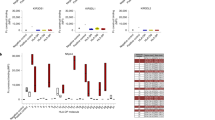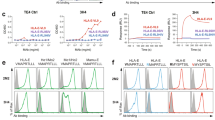Abstract
Activating and inhibitory receptors on natural killer (NK) cells have a crucial role in innate immunity, although the basis of the engagement of activating NK cell receptors is unclear. The activating receptor Ly49H confers resistance to infection with murine cytomegalovirus by binding to the 'immunoevasin' m157. We found that m157 bound to the helical stalk of Ly49H, whereby two m157 monomers engaged the Ly49H dimer. The helical stalks of Ly49H lay centrally across the m157 platform, whereas its lectin domain was not required for recognition. Instead, m157 targeted an 'aromatic peg motif' present in stalks of both activating and inhibitory receptors of the Ly49 family, and substitution of this motif abrogated binding. Furthermore, ligation of m157 to Ly49H or Ly49C resulted in intracellular signaling. Accordingly, m157 has evolved to 'tackle the legs' of a family of NK cell receptors.
This is a preview of subscription content, access via your institution
Access options
Subscribe to this journal
Receive 12 print issues and online access
$209.00 per year
only $17.42 per issue
Buy this article
- Purchase on Springer Link
- Instant access to full article PDF
Prices may be subject to local taxes which are calculated during checkout






Similar content being viewed by others
References
Davis, M.M. & Bjorkman, P.J. T-cell antigen receptor genes and T-cell recognition. Nature 334, 395–402 (1988).
Tortorella, D., Gewurz, B.E., Furman, M.H., Schust, D.J. & Ploegh, H.L. Viral subversion of the immune system. Annu. Rev. Immunol. 18, 861–926 (2000).
Yokoyama, W.M. & Plougastel, B.F. Immune functions encoded by the natural killer gene complex. Nat. Rev. Immunol. 3, 304–316 (2003).
Natarajan, K., Dimasi, N., Wang, J., Mariuzza, R.A. & Margulies, D.H. Structure and function of natural killer cell receptors: multiple molecular solutions to self, nonself discrimination. Annu. Rev. Immunol. 20, 853–885 (2002).
Smyth, M.J., Hayakawa, Y., Takeda, K. & Yagita, H. New aspects of natural-killer-cell surveillance and therapy of cancer. Nat. Rev. Cancer 2, 850–861 (2002).
McQueen, K.L. & Parham, P. Variable receptors controlling activation and inhibition of NK cells. Curr. Opin. Immunol. 14, 615–621 (2002).
Anderson, S.K., Ortaldo, J.R. & McVicar, D.W. The ever-expanding Ly49 gene family: repertoire and signaling. Immunol. Rev. 181, 79–89 (2001).
Brown, M.G. et al. Vital involvement of a natural killer cell activation receptor in resistance to viral infection. Science 292, 934–937 (2001).
Lee, S.H. et al. Susceptibility to mouse cytomegalovirus is associated with deletion of an activating natural killer cell receptor of the C-type lectin superfamily. Nat. Genet. 28, 42–45 (2001).
Smith, H.R. et al. Recognition of a virus-encoded ligand by a natural killer cell activation receptor. Proc. Natl. Acad. Sci. USA 99, 8826–8831 (2002).
Rawlinson, W.D., Farrell, H.E. & Barrell, B.G. Analysis of the complete DNA sequence of murine cytomegalovirus. J. Virol. 70, 8833–8849 (1996).
Cosman, D. et al. A novel immunoglobulin superfamily receptor for cellular and viral MHC class I molecules. Immunity 7, 273–282 (1997).
Adams, E.J. et al. Structural elucidation of the m157 mouse cytomegalovirus ligand for Ly49 natural killer cell receptors. Proc. Natl. Acad. Sci. USA 104, 10128–10133 (2007).
Corbett, A.J., Coudert, J.D., Forbes, C.A. & Scalzo, A.A. Functional consequences of natural sequence variation of murine cytomegalovirus m157 for Ly49 receptor specificity and NK cell activation. J. Immunol. 186, 1713–1722 (2011).
Daniels, K.A. et al. Murine cytomegalovirus is regulated by a discrete subset of natural killer cells reactive with monoclonal antibody to Ly49H. J. Exp. Med. 194, 29–44 (2001).
Arase, H., Mocarski, E.S., Campbell, A.E., Hill, A.B. & Lanier, L.L. Direct recognition of cytomegalovirus by activating and inhibitory NK cell receptors. Science 296, 1323–1326 (2002).
McWhorter, A.R. et al. Natural killer cell dependent within-host competition arises during multiple MCMV infection: consequences for viral transmission and evolution. PLoS Pathog. 9, e1003111 (2013).
Andrews, D.M. et al. Innate immunity defines the capacity of antiviral T cells to limit persistent infection. J. Exp. Med. 207, 1333–1343 (2010).
Long, E.O. Regulation of immune responses through inhibitory receptors. Annu. Rev. Immunol. 17, 875–904 (1999).
Smith, K.M., Wu, J., Bakker, A.B., Phillips, J.H. & Lanier, L.L. Ly-49D and Ly-49H associate with mouse DAP12 and form activating receptors. J. Immunol. 161, 7–10 (1998).
Back, J. et al. Distinct conformations of Ly49 natural killer cell receptors mediate MHC class I recognition in trans and cis. Immunity 31, 598–608 (2009).
Dam, J. et al. Variable MHC class I engagement by Ly49 natural killer cell receptors demonstrated by the crystal structure of Ly49C bound to H-2Kb. Nat. Immunol. 4, 1213–1222 (2003).
Deng, L. et al. Molecular architecture of the major histocompatibility complex class I-binding site of Ly49 natural killer cell receptors. J. Biol. Chem. 283, 16840–16849 (2008).
Tormo, J., Natarajan, K., Margulies, D.H. & Mariuzza, R.A. Crystal structure of a lectin-like natural killer cell receptor bound to its MHC class I ligand. Nature 402, 623–631 (1999).
Wang, J. et al. Binding of the natural killer cell inhibitory receptor Ly49A to its major histocompatibility complex class I ligand. Crucial contacts include both H-2Dd AND β2-microglobulin. J. Biol. Chem. 277, 1433–1442 (2002).
Matsumoto, N., Mitsuki, M., Tajima, K., Yokoyama, W.M. & Yamamoto, K. The functional binding site for the C-type lectin–like natural killer cell receptor Ly49a spans three domains of its major histocompatibility complex class I ligand. J. Exp. Med. 193, 147–158 (2001).
Choi, T., Ferris, S.T., Matsumoto, N., Poursine-Laurent, J. & Yokoyama, W.M. Ly49-dependent NK cell licensing and effector inhibition involve the same interaction site on MHC ligands. J. Immunol. 186, 3911–3917 (2011).
Brennan, J., Mahon, G., Mager, D.L., Jefferies, W.A. & Takei, F. Recognition of class I major histocompatibility complex molecules by Ly-49: specificities and domain interactions. J. Exp. Med. 183, 1553–1559 (1996).
Voigt, V. et al. Murine cytomegalovirus m157 mutation and variation leads to immune evasion of natural killer cells. Proc. Natl. Acad. Sci. USA 100, 13483–13488 (2003).
Back, J., Chalifour, A., Scarpellino, L. & Held, W. Stable masking by H-2Dd cis ligand limits Ly49A relocalization to the site of NK cell/target cell contact. Proc. Natl. Acad. Sci. USA 104, 3978–3983 (2007).
Kielczewska, A., Kim, H.S., Lanier, L.L., Dimasi, N. & Vidal, S.M. Critical residues at the Ly49 natural killer receptor's homodimer interface determine functional recognition of m157, a mouse cytomegalovirus MHC class I-like protein. J. Immunol. 178, 369–377 (2007).
Evans, E.J. et al. The T cell surface—how well do we know it? Immunity 19, 213–223 (2003).
Xu, C., Call, M.E. & Wucherpfennig, K.W. A membrane-proximal tetracysteine motif contributes to assembly of CD3δɛ and CD3γɛ dimers with the T cell receptor. J. Biol. Chem. 281, 36977–36984 (2006).
Moody, A.M. et al. Developmentally regulated glycosylation of the CD8αβ coreceptor stalk modulates ligand binding. Cell 107, 501–512 (2001).
Hartmann, J. et al. The stalk domain and the glycosylation status of the activating natural killer cell receptor NKp30 are important for ligand binding. J. Biol. Chem. 287, 31527–31539 (2012).
Yoder, J. & Litman, G. The phylogenetic origins of natural killer receptors and recognition: relationships, possibilities, and realities. Immunogenetics 63, 123–141 (2011).
Béziat, V. et al. NK cell responses to cytomegalovirus infection lead to stable imprints in the human KIR repertoire and involve activating KIRs. Blood 121, 2678–2688 (2013).
Gumá, M. et al. Imprint of human cytomegalovirus infection on the NK cell receptor repertoire. Blood 104, 3664–3671 (2004).
Davis, A.H., Guseva, N.V., Ball, B.L. & Heusel, J.W. Characterization of murine cytomegalovirus m157 from infected cells and identification of critical residues mediating recognition by the NK cell receptor Ly49H. J. Immunol. 181, 265–275 (2008).
French, A.R. et al. Escape of mutant double-stranded DNA virus from innate immune control. Immunity 20, 747–756 (2004).
Clements, C.S., Kjer-Nielsen, L., Kostenko, L., McCluskey, J. & Rossjohn, J. The production, purification and crystallization of a soluble form of the nonclassical MHC HLA-G: the essential role of cobalt. Acta Crystallogr. Sect. F Struct. Biol. Cryst. Commun. 62, 70–73 (2006).
Aricescu, A.R., Lu, W. & Jones, E.Y. A time- and cost-efficient system for high-level protein production in mammalian cells. Acta Crystallogr. D Biol. Crystallogr. 62, 1243–1250 (2006).
Schuck, P. Size-distribution analysis of macromolecules by sedimentation velocity ultracentrifugation and lamm equation modeling. Biophys. J. 78, 1606–1619 (2000).
Holst, J. et al. Generation of T-cell receptor retrogenic mice. Nat. Protoc. 1, 406–417 (2006).
Sullivan, L.C. et al. The heterodimeric assembly of the CD94–NKG2 receptor family and implications for hman leukocyte antigen-E recognition. Immunity 27, 900–911 (2007).
Acknowledgements
We thank the staff of the crystallization facility of Monash University for assistance; A. Shahine, R. Koh, M. Peverelli and I. Larma for technical assistance; S. Lemieux (Institut Armand-Frappier) for the 4LO3311 hybridoma; and W. Yokoyama (Washington University) for BWZ HD12 and BWZ DAP12 cells and the 3D10 hybridoma. This research was undertaken on the MX2 beamline at the Australian Synchrotron, Victoria, Australia. Supported by the National Health and Medical Research Council of Australia (M.J.C., R.B., L.C.S., J.D.C. and J.R.), Australian Research Council (M.A.P., M.J.C. and J.P.V.) and Pfizer Australia (T.B.).
Author information
Authors and Affiliations
Contributions
R.B. solved the structure, undertook analysis, designed, did and interpreted experiments and contributed to the writing of the manuscript; N.N., P.M.S., J.P.V., J.L., F.A.D., A.J.C., C.A.F., J.M.W., L.C.S., A.D.M., M.A.P., M.J.C., A.A.S. and M.A.D.-E. provided reagents, did experiments and/or contributed to the writing of the manuscript; J.D.C. designed, undertook and analyzed the signaling experiments and contributed to the writing of the manuscript; and T.B., A.G.B. and J.R. contributed to the design and interpretation of experiments, project management and the writing of the manuscript.
Corresponding authors
Ethics declarations
Competing interests
The authors declare no competing financial interests.
Supplementary information
Supplementary Text and Figures
Supplementary Figures 1–6 and Supplementary Tables 1–2 (PDF 5178 kb)
Rights and permissions
About this article
Cite this article
Berry, R., Ng, N., Saunders, P. et al. Targeting of a natural killer cell receptor family by a viral immunoevasin. Nat Immunol 14, 699–705 (2013). https://doi.org/10.1038/ni.2605
Received:
Accepted:
Published:
Issue Date:
DOI: https://doi.org/10.1038/ni.2605
This article is cited by
-
Modulation of innate and adaptive immunity by cytomegaloviruses
Nature Reviews Immunology (2020)
-
A subset of HLA-DP molecules serve as ligands for the natural cytotoxicity receptor NKp44
Nature Immunology (2019)
-
Recognition of host Clr-b by the inhibitory NKR-P1B receptor provides a basis for missing-self recognition
Nature Communications (2018)
-
Natural killer cell specificity for viral infections
Nature Immunology (2018)
-
The identification of additional zebrafish DICP genes reveals haplotype variation and linkage to MHC class I genes
Immunogenetics (2016)



